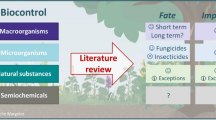Abstract
The fungus, Esteya vermicola has been proposed as biocontrol agent against pine wilting disease caused by Bursaphelenchus xylophilus. In this study, we reported the effects of temperature and different additives on the viability and biocontrol efficacy of E. vermicola formulated by alginate-clay. The viability of the E. vermicola formulation was determined for six consecutive months at temperature ranged from −70 to 25 °C. The fresh conidia without any treatment were used as control. Under the optimal storage conditions with E. vermicola alginate-clay formulation, the results suggested that E. vermicola alginate-clay formulation with a long shelf life could be a non-vacuum-packed formulation that contains 2 % sodium alginate and 5 % clay at 4 °C. Three conidial formulations prepared with additives of 15 % glycerol, 0.5 % yeast extract and 0.5 % herbal extraction, respectively significantly improved the shelf life. In addition, these tested formulations retained the same biocontrol efficacy as the fresh conidial against pinewood nematode. This study provided a tractable and low-cost method to preserve the shelf life of E. vermicola.





Similar content being viewed by others
References
Behle RW, Jackson MA, Flor-Weiler LB (2013) Efficacy of a granular formulation containing metarhizium brunneum F52 (Hypocreales: Clavicipitaceae) microsclerotia against nymphs of Ixodes scapularis (Acari: Ixoididae). J Econ Entomol 106(1):57–63
Duan WJ, Yang EC, Xiang MC, Liu XZ (2008) Effect of storage conditions on the survival of two potential biocontrol agents of nematodes, the fungi Paecilomyces lilacinus and Pochonia chlamydosporia. Biocontrol Sci Tech 18(6):613–620. doi:10.1080/09583150802161868
Gock MA, Hocking AD, Pitt JI, Poulos PG (2003) Influence of temperature, water activity and pH on growth of some xerophilic fungi. Int J Food Microbiol 81(1):11–19. doi:10.1016/S0168-1605(02)00166-6
Lewis JA, Fravel DR, Lumsden RD, Shasha B (1995) Application of biocontrol fungi in granular formulations of pregelatinized starch-flour to control damping-off diseases caused by Rhizoctonia solani. Biol Control 5(3):397–404
Liou JY, Shih JY, Tzean SS (1999) Esteya, a new nematophagous genus from Taiwan, attacking the pinewood nematode (Bursaphelenchus xylophilus). Mycol Res 103(2):242–248. doi:10.1017/s0953756298006984
Mejri D, Gamalero E, Souissi T (2013) Formulation development of the deleterious rhizobacterium Pseudomonas trivialis X33d for biocontrol of brome (Bromus diandrus) in durum wheat. J Appl Microbiol 114(1):219–228
Pavone D, Díaz M, Trujillo L, Dorta B (2009) A granular formulation of Nomuraea rileyi Farlow (Samson) for the control of Spodoptera frugiperda (Lepidoptera: Noctuidae). Interciencia 34(2):130
Quimby PC, Zidack NK, Boyette CD, Grey WE (1999) A simple method for stabilizing and granulating fungi. Biocontrol Sci Tech 9(1):5–8. doi:10.1080/09583159929857
Sabuquillo P, De Cal A, Melgarejo P (2010) Development of a dried Penicillium oxalicumconidial formulation for use as a biological agent against Fusarium wilt of tomato: selection of optimal additives and storage conditions for maintaining conidial viability. Biol Control 54(3):221–229
Shabana YM, Müller-Stöver D, Sauerborn J (2003) Granular pesta formulation of Fusarium oxysporum f. sp. orthoceras for biological control of sunflower broomrape: efficacy and shelf-life. Biol Control 26(2):189–201. doi:10.1016/S1049-9644(02)00130-5
Teshler MP, Ash GJ, Zolotarov Y, Watson AK (2007) Increased shelf life of a bioherbicide through combining modified atmosphere packaging and low temperatures. Biocontrol Sci Tech 17(4):387–400. doi:10.1080/09583150701213695
Trivedi P, Pandey A, Palni LMS (2005) Carrier-based preparations of plant growth-promoting bacterial inoculants suitable for use in cooler regions. World J Microbiol Biotechnol 21(6–7):941–945
Wang CY, Fang ZM, Sun BS, Gu LJ, Zhang KQ, Sung C-K (2008) High infectivity of an endoparasitic fungus strain, Esteya vermicola, against nematodes. J Microbiol 46(4):380–389
Wang CY, Fang ZM, Wang Z, Gu LJ, Sun BS, Zhang DL, Sung CK (2009) High infection activities of two Esteya vermicola isolates against pinewood nematode. Afr J Microbiol Res 3(10):581–584
Wang Z, Wang CY, Gu LJ, Wang YB, Zhang YA, Sung CK (2011) Growth of Esteya vermicola in media amended with nitrogen sources yields conidia with increased predacity and resistance to environmental stress. Can J Microbiol 57(10):838–843
Wang Y, Wang C, Wang Z, Xue J, Li Z, Li J, Gu L, Hou J, Lee M, Ma R (2012) Laboratory studies on the development of a conidial formulation of Esteya vermicola. Biocontrol Sci Tech 22(11):1362–1372
Xue J, Hou J, Zhang Y, Wang Y, Wang C, Wang Z, Wang Y, Sung C (2013) A method for the enhancement of environmental stress resistance of endoparasitic fungus Esteya vermicola. J Phytopathol 161:353–358
Yánez-Mendizábal V, Vinas I, Usall J, Torres R, Solsona C, Abadias M, Teixido N (2012) Formulation development of the biocontrol agent Bacillus subtilis strain CPA-8 by spray-drying. J Appl Microbiol 112(5):954–965
Acknowledgments
This work was supported by the State Forestry Bureau of 948 project (Grant No. 2012-4-70) P. R. China and Ministry of Agriculture and Forestry, South Korea.
Author information
Authors and Affiliations
Corresponding author
Rights and permissions
About this article
Cite this article
Xue, J.J., Hou, J.G., Zhang, Y.A. et al. Optimization of storage condition for maintaining long-term viability of nematophagous fungus Esteya vermicola as biocontrol agent against pinewood nematode. World J Microbiol Biotechnol 30, 2805–2810 (2014). https://doi.org/10.1007/s11274-014-1704-2
Received:
Accepted:
Published:
Issue Date:
DOI: https://doi.org/10.1007/s11274-014-1704-2




